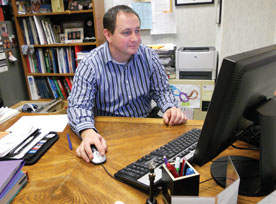…and the man who untangles it all
By Brigid Kelly
Talon Staff Writer
He was teaching a Lego Robotics class last summer when something hit him. No, it wasn’t a catapulted Lego, but an idea. Academic Dean Mike DiNardo couldn’t find a period where all of Honors French V students could be in one class.
“I suddenly had the idea to call [senior] Rachel Orr to ask her about the math course she wanted to take,” recalled DiNardo. “When she told me she was thinking about waiving into a higher math class, I was ecstatic. That decision made it so everyone could fit into one period of Honors French V.”

Mike DiNardo, Minnehaha's academic dean, spends months creating the school's master schedule, as he tries to accommodate each student's request. (Photo by Brigid Kelly)
Yes, ecstatic. DiNardo devotes a great amount of brain power and energy to make each student’s experience at Minnehaha the best it can be by tailoring a mass schedule to meet each individual’s wishes. But it’s not easy by any means. Just consider the variables involved: the current students; the attrition rate; the number of potential students; the available teachers (half time, full time); the accessible rooms (size, equipment); the maximum class size; the minimum class size; the type of course (participation style, difficulty level). And you thought selecting the classes for your own schedule was difficult. While you’re deciding between a fine arts elective and Choir, DiNardo is anticipating another six months of solving a giant thorny brainteaser – the schedule.
“I just try to be creative,” explained DiNardo on his approach to creating schedules. “My mind just works the right way. I can factor inall of the variables while trying to solve the bigger puzzle.”
DiNardo has been the academic dean and scheduling master for six years.
“I remember the first time I did the scheduling on my own,” said DiNardo. “I thought, ‘I’m going to put together the perfect schedule for teachers. They’ll have the perfect prep hours and class times.’ Turns out it wasn’t that easy. There’s more to it than I thought.”
Senior Holly Johnson has experienced the difficulty of the task, first hand.
“I have a lot of classes that are only offered one hour – such as AP Physics, AP Spanish, and Journalism, so I wasn’t able to take my first choice elective,” explained Johnson. “I didn’t want a free hour so I contacted Mr. DiNardo, by email and he was then able to find a one semester class that fit with my schedule.”
The process
The schedule that you follow five days a week is the result of months of discussion, configuring and rearranging from DiNardo, Principal Nancy Johnson and Administrative Assistant for the Academic Dean Kris Anderson. The process of creating each individual’s schedule requires much more than simply plugging numbers into a computer system.
“It takes about six months,” said DiNardo as he counted on his fingers. “I’m not done working with the information that students just entered until August.”
The technology behind scheduling, however, has improved since Dean of Students Lance Johnson was responsible for organizing classes.
“The first few years I did [the scheduling] we didn’t use a computer at all,” said Johnson. “We took a giant magnetic board and listed all the classes. Then we used a calculator to figure out the rest [of the details]. It wasn’t my favorite thing to do by any means.”
Thanks to new developments in the computer world, Minnehaha now takes advantage of a program called Senior Systems – though it’s only implemented after all the other variables have been accounted for by hand.
“Senior Systems was brought to Minnehaha in the late 1980’s,” said Principal Nancy Johnson, who was Academic Dean and scheduling master from 2002 to 2005, “but most of the academic components were not put into place until the late 90’s.”
As DiNardo explained the several steps of the process before even touching Senior Systems, he pulled out a large stack of computer paper. The papers were covered with pencil marks and eraser smudges from experimenting with factors like class order, number of sections to be offered, room availability and teacher expertise – all in attempt to accommodate for the most students possible.
“It’s really student driven,” said DiNardo on the scheduling process. “The student demand drives what we choose to offer as classes and how it all ends up.”
An intricate puzzle
Registration deadline for the 2011-2012 school year just passed on January 31. Students entered their class choices on the Redhawk Online Registration System (RORS), and now the information is being summarized into a report soon to be received by DiNardo. The report will come by individual student with their desired courses listed and by each class and the number of students who signed up for it.
“I work with Nancy Johnson to figure out staffing issues,” said DiNardo. “Do we need to hire someone new? Cut certain positions? Maybe not offer a certain class? We make those decisions very carefully.”
After the student reports are received DiNardo must determine how many sections of a given class will be offered – how many hours of English 10 will there be? How many AP World History sections are needed to accommodate for all the students that were accepted?
“Then we consult the [class] department chairs,” said DiNardo. “The teachers decide what they want to teach the next year and report back [to us]. After that comes the erasing.”
At this point, DiNardo pulls out a set of worksheets for each department – math, science, world languages, etc. – that will help him determine the order of the classes.
“We try to avoid having faculty teach for the one, three, five, seven periods [without a prep hour],” said DiNardo on the several roadblocks of the process. “Plus there are teachers that share rooms and that needs to be considered.”
Once the best possible puzzle has been fitted together, Anderson transfers the penciled in, erased and finally rewritten information from the worksheets to Senior Systems. Because of the modified block schedule at Minnehaha, this is the first possible step that Senior Systems can be used in a beneficial manner.
“Around here, we affectionately say we ‘push the button,'” said DiNardo.
Then another report is created with “percent fully scheduled” numbers listed by grade. In other words, the report reflects the number of students who have a full seven-class schedule.
“We’d love for it to say 100 percent [for each grade level],” admitted DiNardo, “but it never does. If we get anywhere near 75 to 80 percent, I’m ecstatic.”
Then it becomes yet another puzzle. Moving class times and shifting individual course selections.
“In May and June I’ll be erasing, trying again, erasing and trying again,” said DiNardo. “I get to a point where I need to stop trying and decide on a final schedule. We have to make the required classes fit, and I hate it when the variables don’t allow it to work for every kid.”
Once the schedule is decided, Anderson and DiNardo sift through each individual enrolled at Minnehaha to make sure the graduation requirements are being met and that each student has a full schedule.
Along with teaching two sections of AP Statistics and coaching both middle school and high school sports, DiNardo has the catch-all (and year round) job of figuring out the master puzzle for each semester, speaking with struggling students and inquisitive parents and working with individuals of the student body in finding the best course for their future.
You’ve selected your desired classes for next school year. Those selections are now being translated into several reports soon to be toiled over by DiNardo. Just think – those seven choices will be one of the many vital pieces to the convoluted puzzle of scheduling.

